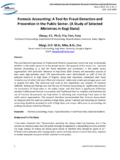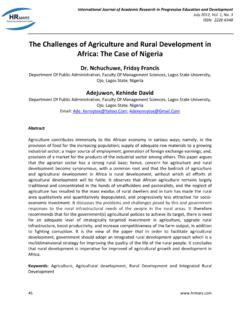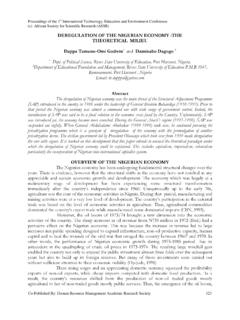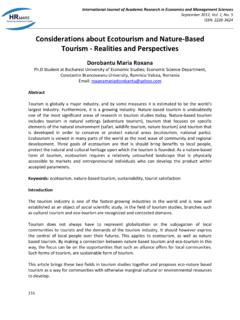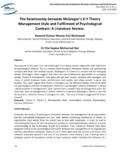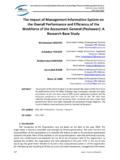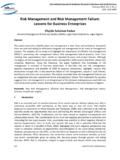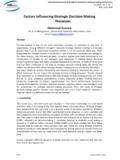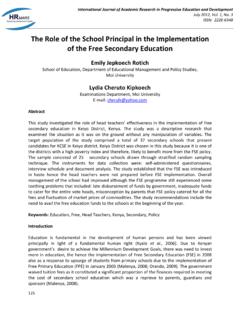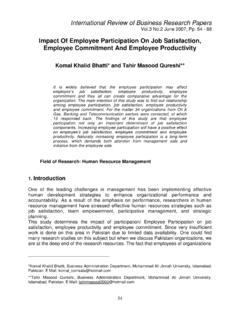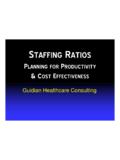Transcription of Designing a Model for Measuring Manpower …
1 International Journal of Academic Research in Business and Social Sciences February 2013, Vol. 3, No. 2. ISSN: 2222-6990. Designing a Model for Measuring Manpower Productivity in the Project-based Service Organizations (Electricity Company as Case Study). Abolfazl Sherafat PhD Student, Production and Operations Management, Tehran University Ahmad Vatankhah Tafti Faculty of Management, Islamic Azad University, Dehaghan Branch, Isfahan, Iran Ahmad Reza Yazdani Faculty of Management, Islamic Azad University, Dehaghan Branch, Isfahan, Iran Sayyed Mohammad Reza Davoodi PhD Student, Faculty of Management, Islamic Azad University, Dehaghan Branch, Isfahan, Iran Abstract Manpower productivity index is one of the most important productivity measures. This index is the ratio of added-value to number of the employees (or the employee's salaries). Regarding this fact that Manpower cost, annual depreciation, and annual profit is almost fixed and isn't indicative of the organizations actual performance, therefore Measuring added-value in the common methods is fixed and unrealistic and is not function of the organizational performance.
2 Therefore, with respect to the project-based nature of such organizations, a large amount of their budget is spent for the projects in progress and hence Measuring the added-value through the common formula and without considering projects means that large amount of the organizations capital and Manpower , which are involved in the project implementation, are not considered in Measuring added-value. Therefore, in order to measure the actual performance of the organization, the added-value that is gained from the projects future exploitation should be added to its added-value. In the designed Model , added-value is calculated so that all of the organizations outputs include current activities and also the investments that will be exploited in the future. As a result, the calculated value is overall reflects of the organizations performance and also Manpower productivity is calculated actually.
3 In order to measure the productivity in this method, the actual added-value that is achieved from offering the services should be extracted from financial statements. In order to measure the added-value of the projects in progress, the future incomes from their exploitation are 172 International Journal of Academic Research in Business and Social Sciences February 2013, Vol. 3, No. 2. ISSN: 2222-6990. simulated during the projects lifetime and then take from maintenance costs and inputs; its present value is calculated for the base year through engineering economics formula. Since, Manpower productivity is the ratio of added-value to the organizations Manpower , it is possible to measure every units and employee's productivity through determining every their role by organizational excellence models in creating the added-value and then determining their role in the units added-value.
4 The designed Model is implemented in an organization with the mission of supplying and distributing the electricity energy and then every units productivity in this organization is calculated through this method. Keywords: Productivity Measurement, the Potential added-value, the Actual added-value, and Project-based organization Introduction Hoisin introduced the productivity for the first time in 1776. After about a century in 1833, Liter defined productivity as the power and ability of producing [4]. Nowadays, the organizations are forced to achieve the best outputs regarding their limited resources. The productivity is an index for evaluating systems performance and determining the extent of their success or failure in achieving the goals regarding the appropriate consumption [7]. Increase the productivity at the national level leads to improve in citizen's life quality, decrease in the inflation, and create competitiveness potentiality in this level.
5 This is strived from increasing productivity of the organizations, businesses, and economic institutes. Therefore, this can be considered as an index for evaluating progress and development of a country in comparison to other ones. Productivity is the main core of competition at the organizational level in combining the production factors for creating more value. Therefore, the productivity measurement can be used in terms of two dimensions that the first is change in the productivity measurements trend during the time periods that help the organization to analyze the reasons of increase or decrease in the productivity in different areas and the second is comparing the productivity with the other organizations and institutes for determining relative position that can be used as the beneficial instrument in the future planning about products, services, process, market, and other factors in a competitive environment.
6 Manpower productivity is one of the most important productivity measures. This is the ratio of the added-value to the employees or their salaries. In this study, a Model was designed as the main factor of determining the Manpower productivity index with respect to the characteristics and conditions of project-based public service organizations. With respect to the purpose of this study that is to measure the Manpower productivity in each of the organizational main departments, a mechanism was developed for determining the role of each unit in the total 173 International Journal of Academic Research in Business and Social Sciences February 2013, Vol. 3, No. 2. ISSN: 2222-6990. added-value and finally the Manpower productivity was studied in the organization and also Manpower productivity of each unit was measured. Literature review In addition to the inconsistent productivity measurement problem, another issue that contributes to the complexity of productivity estimating is the existence of numerous productivity-influencing actors, such as weather and labor skill.
7 Productivity rates can fluctuate considerably due to the influence of these factors. Numerous studies have been conducted to examine the productivity influencing factors of various construction activities, such as concrete construction [1], masonry construction [2], pile construction [3], and bridge false work [4]. Therefore, a number of modeling techniques have been introduced to study the relationship between influencing factors and productivity for estimating purposes. These modeling techniques include statistical and regression models, expert systems, artificial intelligence, and simulation. For example, regression-based models were used to study earthmoving productivity [5] and masonry productivity [2,6]. An example of using expert systems for productivity modeling is the system developed by Hendrickson et al. _1987_ for masonry construction.
8 Fayek and Oduba [7] applied fuzzy expert systems to predict productivity of pipe rigging and welding. studies of Measuring and Modeling Labor Productivity Using Historical Data[8] presents an approach to Measuring productivity, collecting historical data, and developing productivity models using historical data. The selection of productivity modeling techniques is primarily determined by the quantity and nature of influencing factors, the complexity of the mapping relationship, and the capability of a particular modeling method, as well as a researcher's preference. ANN and simulation were successfully applied in this research. ANN is found to be effective in modeling individual activities that have complex detail operations and a complex mapping relationship between productivity and influencing factors. Simulation combined with ANN was successfully applied to Model the productivity of a production system that consists of a number of related activities.
9 The proposed methodology and the industrial case study standardized the measurement of productivity in steel drafting and fabrication projects and improved the collection and utilization of productivity data by standardizing its structure and enhancing its interpretation and analysis. To measure the productivity of a government production unit, we need to measure the prices and quantities of the outputs produced and inputs used by that unit or establishment for two periods of time. Then productivity growth can be defined as a quantity index of outputs produced divided by a quantity index of inputs used by the establishment.[9,10] It is usually possible to measure the price and quantity of inputs in a fairly satisfactory manner[11] but there are problems in Measuring the prices and quantities of government nonmarket outputs. The paper of Measuring productivity in the public sector [12] analyzes three possible general methods to measure the price and quantity of nonmarket government outputs.
10 If quantity 174 International Journal of Academic Research in Business and Social Sciences February 2013, Vol. 3, No. 2. ISSN: 2222-6990. information on nonmarket outputs is available, then the first two methods of price valuation rely on either purchaser based valuations or on cost based valuations. If little or no information on the quantity of nonmarket outputs produced is available, then the method recommended in the System of National Accounts 1993 must be used, where aggregate output growth is set equal to aggregate input growth. Despite the existence of well-developed frameworks within academic economics for thinking about productivity, there appears to be no consensus amongst industry researchers about how to investigate productivity performance in construction. The seminal report on The Social and Economic Value of Construction [13] cites estimates [14] for labor and total factor productivity (TFP) which suggest that the UK construction industry's international record on average labor productivity (ALP) is not as good as its record on TFP.
